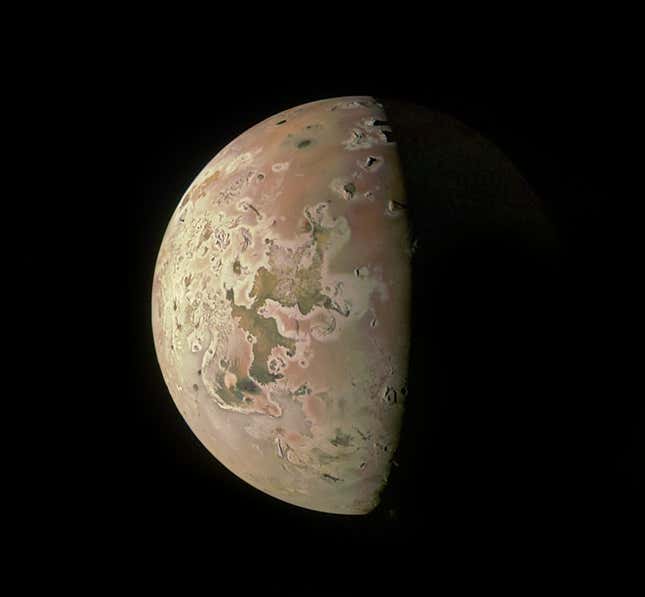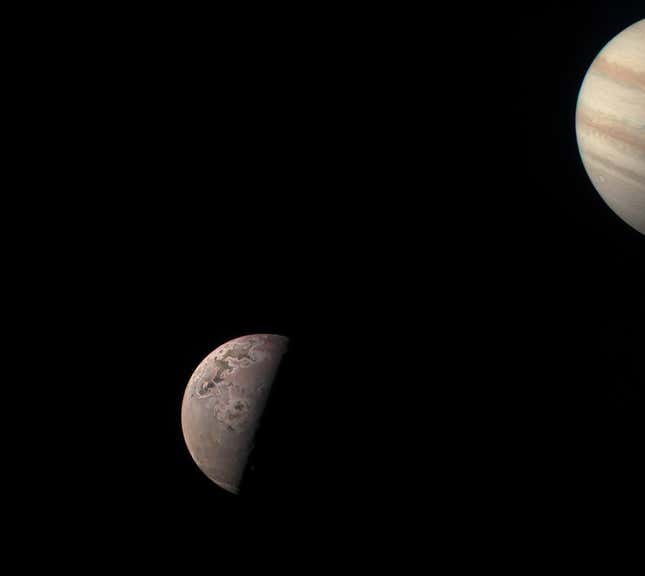After years of capturing the large world of Jupiter, the Juno spacecraft has lately turned its consideration to its Jovian moons. Throughout a detailed flyby of Jupiter’s spookiest moon, Juno imaged the charred floor of a volcanic world caught in a haunting gravitational tug.
This week, NASA shared new photographs taken by the Juno spacecraft throughout its flyby of Jupiter’s moon Io on October 15. The photographs reveal an ominous view of probably the most volcanically energetic world within the photo voltaic system, which has clearly been by loads over the previous 4.5 billion years.
Photos captured by Juno are launched to the general public by the mission’s website, and infrequently occasions information visualization artists work their magic on the uncooked information to create stunning renderings. This one above was processed by software program engineer Kevin Gill, whereas the one under was edited by Ted Stryk.

That is maybe the clearest view we’ve seen of Io because the Juno spacecraft inches its approach nearer to the moon. The floor of the moon is mangled by tons of of volcanoes and lakes of molten silicate lava, which is why the moon seems burnt as if it had been by monumental torment.

The moon is wedged between Jupiter’s immense gravitational drive, in addition to the gravitational tug of its sister moons Europa and Ganymede. Consequently, the moon is consistently being stretched and squeezed, which contributes to its volcanic exercise.
NASA’s Juno spacecraft, which has been learning the Jovian system since 2016, noticed Io throughout earlier flybys in Might and July. Juno additionally captured a cozy family photo of Jupiter and Io in September, revealing the fuel big and its moon aspect by aspect. The following time Juno approaches the volcanic world shall be on December 30, in addition to February 1, 2024, after which once more on September 20, 2024, approaching the haunting world with warning to assemble extra information on its exercise.
Because the innermost of Jupiter’s massive moons, Io is the principle supply of many of the charged particles within the planet’s magnetosphere, making a donut-shaped cloud of ions and electrons that encompass Jupiter. The cloud, often called Io Plasma Torus, is shaped when atmospheric gases escaping from Io are ionized.
Throughout upcoming flybys, scientists from the Southwest Analysis Institute (SwRI) will use the Hubble and James Webb telescopes to simultaneously observe the Jovian moon from a distance.
For extra spaceflight in your life, comply with us on X (previously Twitter) and bookmark Gizmodo’s devoted Spaceflight page.
Trending Merchandise

Cooler Master MasterBox Q300L Micro-ATX Tower with Magnetic Design Dust Filter, Transparent Acrylic Side Panel, Adjustable I/O & Fully Ventilated Airflow, Black (MCB-Q300L-KANN-S00)

ASUS TUF Gaming GT301 ZAKU II Edition ATX mid-Tower Compact case with Tempered Glass Side Panel, Honeycomb Front Panel, 120mm Aura Addressable RGB Fan, Headphone Hanger,360mm Radiator, Gundam Edition

ASUS TUF Gaming GT501 Mid-Tower Computer Case for up to EATX Motherboards with USB 3.0 Front Panel Cases GT501/GRY/WITH Handle

be quiet! Pure Base 500DX ATX Mid Tower PC case | ARGB | 3 Pre-Installed Pure Wings 2 Fans | Tempered Glass Window | Black | BGW37

ASUS ROG Strix Helios GX601 White Edition RGB Mid-Tower Computer Case for ATX/EATX Motherboards with tempered glass, aluminum frame, GPU braces, 420mm radiator support and Aura Sync









